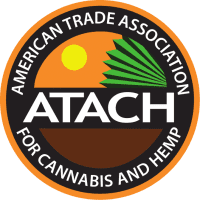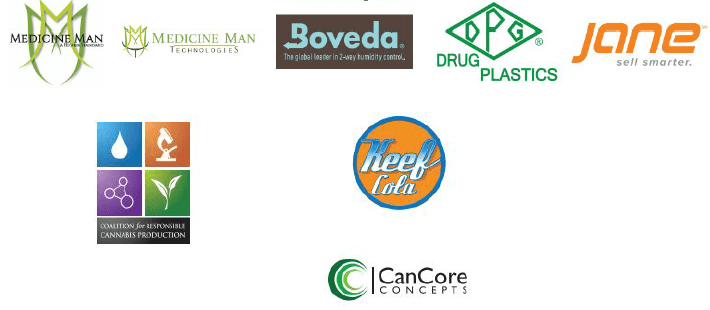Special thanks to legal service providers for advice for ATACH’s regulatory review process:
Special thanks to the following participants in the ATACH review process:
§ 1141.21. _ Definitions.
Batch: As currently defined, “batch” refers to plants “planted AND harvested” at same time. It should be one or the other, and ideally to coincide with the typical tracking system that the state will employ (software tracking typically tracks “harvested together”, not “planted together”).
Controlling Interest: The term needs to be further defined. In a subsequent section, 5% is defined as a controlling interest. Typically 50.1% is considered a controlling interest by law noting anything less than this should not be considered a controlling interest threshold. Under the current draft, it is possible that every investor (event those only holding a percent or quarter of a percent) could be considered as having a controlling interest which would make other requirements in the draft regulations - such as fingerprinting, financial disclosures, tax clearance letters, etc. - overly burdensome to businesses as well as the Department of Health. Additionally, as the regulations are currently defined, property owners who are leasing or optioning a property (we suspect many wouldn’t even know they would be subject to tax and security requirements at the time of optioning the property) is an onerous requirement.
Employee: Under this definition, contractors involved in the process, such as a consultant or a security firm, etc, would be required to undergo background checks related to the application. Typically the Federal government definition of a direct employee should be sufficient for the purposes of defining an employee. Contractors or other non owners who work on a gross wage basis are not considered employees. Additionally, because a contractor would be considered an “employee” under the current draft, a contractor could in theory be barred from receiving any compensation as a contractor from the medical marijuana organization (§1141.30(d)). Also, if the contractor has any prior criminal history for simple possession of a controlled substance (in any amount) they would be barred. For many contractors, this would be unworkable and the burden on the medical marijuana organization itself to make sure it’s contractors are complying isn’t tenable. This is especially true if the organization is required to produce background checks on every employee of every contractor (think waste disposal, maintenance, cleaners, among others).
Lot: The word “dry” should be inserted in front of weight. Wet weight would severely limit the lot size and the current regulations leave wet or dry weight up to interpretation.
§ 1141.24 General requirements for permits.
This section needs to allow for expansion into additional facilities under the same license as companies grows. The regs should allow for continued growth with a site inspection requirement for each additional facility prior to beginning operations at the new facility.
§ 1141.25. Privilege.
§ 1141.26. _ General requirements for application by a medical marijuana Organization.
(e)(2): If the Department of Health is requiring tax clearance letters from the Department of Revenue, there must be an expedited process for Revenue to process for the application. In other states, clearance letters have taken months to obtain. Organizations typically do not sign up investors until later in the process which means letters could also be late and waiting could cause delays.
§ 1141.28. _ Initial permit application.
In (6), the word “employee” should be removed as businesses will not know every employee of the organization at the time of application. These companies typically build an employee base only after a license is awarded. If the department wants “key employees”, that should be specified.
§ 1141.29. _ Capital requirements.
In the case of an individual, partnership, or other pass-through entity, it should be sufficient to show such funds in the aggregate accounts of all the individual members/partners for the application. Should this be permissible, it should be “financial institutions” in plural so the department can count all of the accounts.
§ 1141.32. Review of initial grower/processor permit applications.
Re: (d) “The Department will publish the number of permits to be awarded in each of the three regions in the Pennsylvania Bulletin at the time the initial grower/processor permit application is made available for submission…” In our view, knowing the number of regions and permits within each as the application is released is too late in the process and should be done earlier.
§ 1141.33. _ Denial of an initial permit application.
(5): Currently, the regulations read that the department can deny a license based on denials in other states. This is unreasonable especially if the denial were based on something as simple as a scoring system. For Florida, New York, Hawaii, and Maryland licenses for example, many of the best groups in the country made application and were unsuccessful.
§ 1141.37. Duty to report.
Several potential changes can happen to the application while waiting for licenses to be awarded. The standard to report changes should be “material” changes. This will allow for companies to not be burdened with notifying department of minor changes and the department not to be burdened by processing these changes during scoring. What we have found in other states applications is that a requirement for any change can do the following: (1) overwhelming paperwork of little importance, and (2) essentially let applicants game the process after submission by continually changing and updating the application with “non-material” information.
§ 1141.38. Application for change in ownership of a grower/processor.
(b) A grower/processor shall file an application for a change in ownership… that was approved in an initial permit application or permit renewal application.” This seems to indicate that an applicant will be able to raise the actual funds needed to run the operation (beyond the initial $2 million required to show) by raising equity dollars AFTER the permit has been awards (far easier than BEFORE the permit is awarded).
§ 1141.41. Failure to operate.
The requirement to be ready to operate within 6 months is problematic. Straight build-ups, possibly in winter, would be very tough to achieve. Already occupied structures, even if a business has control, take time to prepare for a build out. Some of issues that arise would be beyond a company’s control, such as waiting on the power company, extra transformers, etc. Companies will race to open as it is in there best interest and we believe that the department should offer more latitude for when licenses are deemed operational.
CHAPTER 1151. GROWERS/PROCESSORS AND MEDICAL MARIJUANA ORGANIZATIONS
§ 1151.21. Growers/processors generally.
Section F. should be deleted as bringing seeds into the Commonwealth and other aspects of the program are in conflict with federal law.
§ 1151.22. Grower/processor regions.
The determination of what constitutes a “serious medical illness” is concerning that one illness might ranked over another for purposes of license awarding. In our view, awarding shouldn’t favor one illness over another. Instead of “serious” medical illness, the standard should be the law’s qualifying conditions.
§ 1151.24. Grower/processor facilities.
Greenhousing should be permissible under the program and should be mentioned in the regulations to remove any ambiguity on this point. In section c, video surveillance should constitute areas that is “easily observable”.
§ 1151.25. Start-up inventory.
In (a), the start-up inventory must include the ability to use immature plants, clones and cuttings as part of the process. If only seeds are allowed and not plant matter, the department is potentially wiping out the years operators have spent breeding and developing genetics for medicines. A reset would be devastating in some cases. This has the potential to delay the rollout of quality medicine to patients. Additionally, the start up period should be increased to 90 days.
§ 1151.26. Visitor access to grower/processor facilities.
There may be cases where specialists/contractors who may be consulting need to touch plants and this provision should allow for that circumstance.
1151.26 Part (f) should remove reference to federal agencies as operators are not afforded protection under federal law.
§ 1151.28. Requirements for growing and processing medical marijuana.
D.1. Growers and processors should maintain the right to use the nutrients that they use to produce medicine.
3.2. For humidity control, we believe that there should be checks of relative humidity of the product and not just the rooms where the product is grown, stored, and processed. Eventually, if the law is extended in the future to permit flower, relative humidity standards for packaging of the product should be applied.
§ 1151.29. Forms of medical marijuana.
2. Under Oil, this section should allow for a “such as” wax, shatter, live resin, rosin, etc. On topicals, a “such as” for items like transdermal patches that will be allowed under the program.
B. This should be changed to read: A grower/processor may not sell or wholesale medical marijuana in dry leaf or plant form. The way the clause currently reads grower/processor licensees wouldn’t be able to work with the portions of the plant needed to extract oils and processes into a usable product as per the guidelines.
§ 1151.30. Limit on medical marijuana production.
Having a one year supply isn’t practical as products may not have a shelf life of a year. Instead, this provisions should be the ability to product a year’s supply of product to meet demand.
§ 1151.31. Inventory.
3. This provision should be satisfied by electronic record as opposed to “written” so it can be a seed to sale tracking report.
D. Seeds shouldn’t be tagged. Typically, it’s plants that are tagged once they have developed roots.
§ 1151.35. Packaging and labelling of medical marijuana.
B. 1. For child-resistant packaging, the package should comply with child-resistance as described in the Poison Prevention Act, 16 CFR 1700 (CFR is code of federal regulations) which is the standard for other industries.
B. 2. Light-resistant and opaque are two different issues and should be separated for clarity. Light resistance speaks to blocking the harmful effects of light on the product contained in the package. For this issue we would suggest that the package complies with the current USP 671 Light Transmission standard, which is 10% or less of part of the UV and Visible of the light spectrum may pass through the container which is measured between 290 nanometers - 450 nanometers. Opacity speaks to making sure the public can't see the product inside of the package and if that’s the intended goal that’s what should be delineated.
B.4. Re-sealable. This can really be folded into the Child-Resistant in this section. The package needs to be child-resistant for the life of the package. So if a multi-dose package it must be child resistant from the first pill to the last. The package needs to be re-sealable in a child resistant way, not just closed again. 16 CFR 1700 of the Poison Prevention Act would cover this type of provision.
Additionally, materials used in packaging for medical cannabis products should be “safe for food contact” as described by 21 CFR 174-186. This would require materials that come into contact with the product - like the inside of the bottle or cartridge or cap - such as FDA approved materials in addition to a few more regulations that would ensure consumer safety. It would also be a good idea for the packaging to demonstrate that it is stable, considering the product is containing and protecting so that the package is compatible with the product and there is no leaching from the container. While this is not widespread in the cannabis industry currently, it would be good foresight for keeping the consumer safe.
§ 1151.40. Disposal of marijuana and medical marijuana.
The department may consider having a separate protocol specifically for the program.
§ 1151.46. Insurance requirements.
The insurance requirements should also include product liability insurance. This would help protect the market against downstream legal action against parties in the chain of custody.



